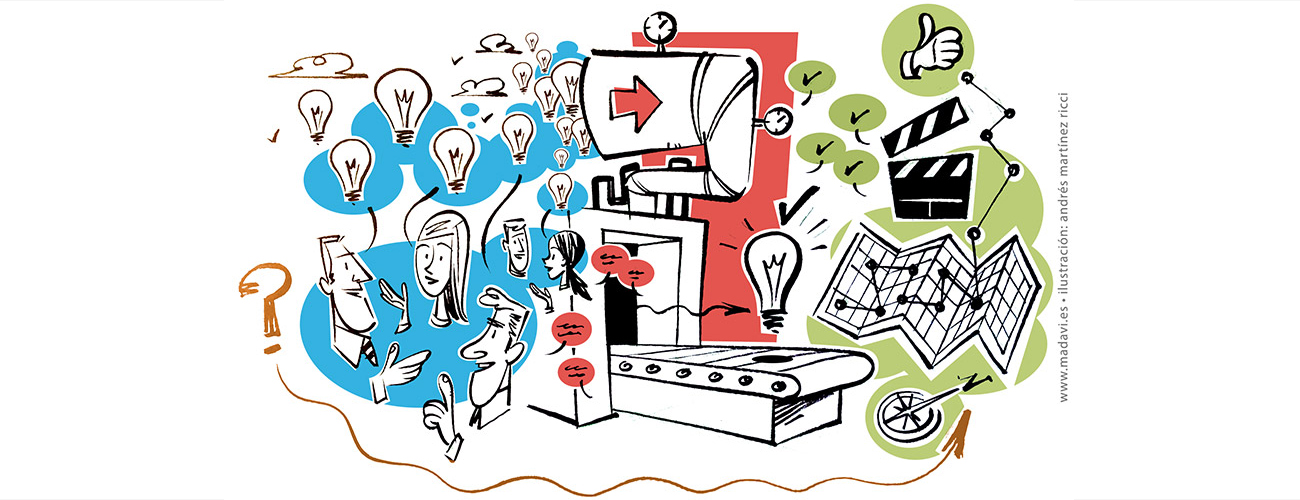To create, innovate and analyse alternatives as a team you must be aware of how our brain works and the peculiarities of productive thinking. Our brain learns endlessly, the difficult thing to achieve is to un-learn, that is why we do not accept concepts that are in apparent contradiction with what we know today. Our brain, as it learns, generates mind sets with which is able to recognise situations and make decisions almost instantaneously. It is what we call reproductive thinking.
Reproductive thinking is essential because it allows us to be efficient and effective. This way of thinking is used to refine current models and take the most common decisions, but does not display of the creative thinking of the team. To be creative we must overcome the reproductive thinking and place ourselves us in productive thinking, that which gives us new insights, new ideas, new variables, new ways to address our aspirations, different ways of looking at what surrounds us.
To co-create is going from my idea to our idea, to put the capabilities of all of us for the challenge of each of us, to challenge each other’s ideas, to find different alternatives together, to really listen; it is the way to be creative as a team.
To co-create requires a completely different schem, it is a matter of dividing the thinking into three phases: blue thinking, red thinking and green thinking. All creation process begins with a question: How….?
Blue thinking
What most characterises this phase of the conversation is that we postpone judgement. It is about exploring new paths. We postpone it in order to allow us to propose new ideas and to give the maximum opportunity to the ideas of others.
The first step is to produce ideas in response to the original question of co-creation. If there are many ideas is often advisable to group them. If we want to innovate it is appropriate to order the ideas, from the most disruptive to the most conservative. The next golden rule is to be committed to developing the idea, which perhaps we judge as absurd but by trying to develop it we can discover unexpected aspects and discover that the “absurd idea” had hidden treasures. We therefore should take a positivistic approach; give every idea the possibility to bear its fruit. As Heraclitus said “expect the unexpected or you will not find it because it leaves no trace”.
Once they are ordered one has to talk about “the why yes”, which relates to the benefits that idea can provide, and about “the how yes” which relates to the ways of making this idea reality. All ideas will be considered valid if the team finds significant advantages in the conversation: “the why yes”. “After this positive filter, it is time to explore how to materialise this idea, focusing the conversation on “the how yes” .
During the Blue thinking process, the fact that an idea is supported does not mean it is accepted, we are simply exploring the scope of the idea. This way of thinking allows all team members to collaborate in a relevant manner ¿ Is collaborating not striving to make the idea of another feasible? This approach will allow us to have many feasible ideas, giving us the freedom to choose. Once all the ideas have been scanned, we may make combinations to generate a range of desirable ideas.
Red thinking
The time has come to choose. We have alternatives, we must weigh them and choose one or more. The first step is to determine the selection criteria: the fastest, the least expensive, the most efficient, the one which generates better customer relations, etc. Once that is done we shall be able to choose.
Green thinking
This is about turning the choices made into reality. To do this, instead of making a detailed action plan, we will determine the first steps to be taken. The action plans normally used are intended to efficiently plan processes which are routine or known. When we create we enter new worlds we will find it impossible to know in advance the whole journey. When we move we forward will learn things that will shed light and from the learning process we shall be able to determine the next steps. If we want to know the whole journey we shall end up discarding the most creative, innovative ideas. This phase is not for tourists. We have become travellers, who discover the next steps to be taken as we advance on the journey.

